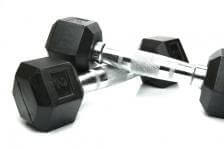Top 7 Gym Mistakes
Learn the most common exercise errors and how to avoid them during your workout.
Ben Greenfield
Listen
Top 7 Gym Mistakes

Get-Fit Guy listener Josh recently asked:
“I’ve been told that performing lat pull-downs or pull-ups behind your head can hurt your back, but many of my friends continue to do the exercises this way. Are they in danger? Or am I missing out on some good muscle training?”
Although I have done an episode on proper gym etiquette, Josh’s question brings up an important concern about exercise movement, so at the end of this episode, I’ll answer whether lat pull-downs or pull-ups should be performed behind or in front of the head.
But first, here are the top 7 gym mistakes, and how you can stay safe and avoid the most common workout errors:
The Top 7 Gym Mistakes
-
Dropping dumbbells to the side after doing a dumbbell bench press
When you’re lying on your back after having completed a set of presses, it can be tempting to simply allow the weights to drop down to the floor at your side. But doing so requires you to hyperextend your shoulders, and significantly increases risk of shoulder injury. Instead, you should place the dumbbells on your thighs, sit up, and then lower the dumbbells to the floor. -
Leaning on treadmill or elliptical rails while going up an incline
Have you ever walked into a gym and seen someone walking up the steepest possible incline on a treadmill, while frantically clutching the rails for dear life? Although that may look like a difficult exercise, it really shuts down your ability to burn calories when you have a death grip on the railing. On both the elliptical trainer and the treadmill, the rails are only there for light support when you absolutely need it. If the incline or resistance is so high that you need to grab the rails, you should simply go easier until you learn to balance yourself during hard efforts. -
Using poor posture on an exercise ball
Ironically, although the exercise ball was developed to strengthen the core, it can significantly hurt your low back if you slouch while sitting, bouncing, or doing crunches on the ball in an uncontrolled fashion. Unfortunately, all of these postural errors are common mistakes. To avoid injury, use an exercise ball properly by keeping your core tight, your shoulder blades back, and your posture tall and proud. -
Doing cable or elastic band exercises too fast
Cable and elastic bands are great strengthening and toning tools, but tend to pull you back into the starting position after you’ve completed an exercise. If you don’t resist this pull, then you miss out on one of the most beneficial phases of the exercise (called the “eccentric” or “negative” phase). With cables or bands, try to maintain an even, steady tempo from start to end of the exercise – and lower the weight if you find yourself unable to control the speed of the second half of your movements. -
Improperly adjusting height settings on exercise machines
While exercise machines can lower risk of injury by guiding you through the proper range of motion, they can actually increase risk of injury (especially for your knees and shoulders) if the seat height settings are not correct. In the episode How To Use Weight Training Machines, you learn that your seat height setting should place the handles of an upper body machine in line with your shoulders, and the rotating portions of a lower body machine in line with your knees. For a bicycle, the seat height should allow you to have a slight bend in your knee at the bottom of the pedal stroke. -
Using too high a cadence and too low a resistance
From spinning classes to elliptical trainers to weight training machines, it is very common to see exercisers moving too fast with too little resistance. If you find yourself bouncing up and down on a bicycle because your feet are moving so fast, you should increase the resistance. If you find yourself swinging your feet so fast the machine is rocking from side to side, you should increase resistance on the elliptical. And if you find yourself rapidly finishing sets on weight training machines at high speeds with no muscle burn, you should increase the resistance. Otherwise, you’re simply not subjecting your muscles to an adequate force for muscle development and wasting valuable gym time. -
Resting between exercises
Unless you’re training with very heavy weights for a sport like powerlifting or football, there is no need to sit and rest for 1-2 minutes between exercises. Instead, you should get the most metabolism-boosting bang for your buck out of a workout by rapidly moving from set to set in a circuit-training workout format, or by doing cardio exercises like jumping jacks or jumping ropes as you wait to do the next set of an exercise. Sitting and reading magazines or staring at the wall is simply not maximizing your time at the gym!
So what about Josh’s question regarding pulling down behind the neck vs. in front of the neck? It certainly is true that when pulling down behind your neck, you can strain the ligaments in your neck if don’t have enough shoulder flexibility. It’s much safer to simply lean back slightly and pull into the upper chest. Josh, warn your friends before they get hurt.
If you have more questions about common gym mistakes, simply share them below in Comments or on the Get-Fit Guy Facebook page!
Image courtesy of Shutterstock

